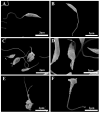Potential Effects of Essential Oil from Plinia cauliflora (Mart.) Kausel on Leishmania: In Vivo, In Vitro, and In Silico Approaches
- PMID: 38276192
- PMCID: PMC10819817
- DOI: 10.3390/microorganisms12010207
Potential Effects of Essential Oil from Plinia cauliflora (Mart.) Kausel on Leishmania: In Vivo, In Vitro, and In Silico Approaches
Abstract
In the search for new chemotherapeutic alternatives for cutaneous leishmaniasis (CL), essential oils are promising due to their diverse biological potential. In this study, we aimed to investigate the chemical composition and leishmanicidal and anti-inflammatory potential of the essential oil isolated from the leaves of Plinia cauliflora (PCEO). The chemical composition of PCEO showed β-cis-Caryophyllene (24.4%), epi-γ-Eudesmol (8%), 2-Naphthalenemethanol[decahydro-alpha] (8%), and trans-Calamenene (6.6%) as its major constituents. Our results showed that the PCEO has moderate cytotoxicity (CC50) of 137.4 and 143.7 μg/mL on mice peritoneal exudate cells (mPEC) and Vero cells, respectively. The PCEO was able to significantly decrease mPEC infection by Leishmania amazonensis and Leishmania braziliensis. The value of the inhibitory concentration (IC50) on amastigote forms was about 7.3 µg/mL (L. amazonensis) and 7.2 µg/mL (L. braziliensis). We showed that PCEO induced drastic ultrastructural changes in both species of Leishmania and had a high selectivity index (SI) > 18. The in silico ADMET analysis pointed out that PCEO can be used for the development of oral and/or topical formulation in the treatment of CL. In addition, we also demonstrated the in vivo anti-inflammatory effect, with a 95% reduction in paw edema and a decrease by at least 21.4% in migration immune cells in animals treated with 50 mg/kg of PCEO. Taken together, our results demonstrate that PCEO is a promising topical therapeutic agent against CL.
Keywords: Plinia cauliflora; chemotherapy; cutaneous leishmaniasis; essential oils; phlogistic signs.
Conflict of interest statement
The authors declare no conflicts of interest.
Figures







Similar articles
-
Antileishmanial Screening, Cytotoxicity, and Chemical Composition of Essential Oils: A Special Focus on Piper callosum Essential Oil.Chem Biodivers. 2023 Feb;20(2):e202200689. doi: 10.1002/cbdv.202200689. Epub 2023 Jan 16. Chem Biodivers. 2023. PMID: 36565272
-
Antileishmanial activity of 4-phenyl-1-[2-(phthalimido-2-yl)ethyl]-1H-1,2,3-triazole (PT4) derivative on Leishmania amazonensis and Leishmania braziliensis: In silico ADMET, in vitro activity, docking and molecular dynamic simulations.Bioorg Chem. 2020 Dec;105:104437. doi: 10.1016/j.bioorg.2020.104437. Epub 2020 Oct 28. Bioorg Chem. 2020. PMID: 33339081
-
In vitro antiparasitic activity and chemical composition of the essential oil from Protium ovatum leaves (Burceraceae).An Acad Bras Cienc. 2017 Oct-Dec;89(4):3005-3013. doi: 10.1590/0001-3765201720170310. Epub 2017 Oct 16. An Acad Bras Cienc. 2017. PMID: 29044326
-
Antileishmanial Activities of Medicinal Herbs and Phytochemicals In Vitro and In Vivo: An Update for the Years 2015 to 2021.Molecules. 2022 Nov 4;27(21):7579. doi: 10.3390/molecules27217579. Molecules. 2022. PMID: 36364404 Free PMC article. Review.
-
Plinia cauliflora (Mart.) Kausel: A comprehensive ethnopharmacological review of a genuinely Brazilian species.J Ethnopharmacol. 2019 Dec 5;245:112169. doi: 10.1016/j.jep.2019.112169. Epub 2019 Aug 16. J Ethnopharmacol. 2019. PMID: 31425732 Review.
References
-
- Ramos E.H., Moraes M.M., Nerys L.L.d.A., Nascimento S.C., Militão G.C., de Figueiredo R.C., da Câmara C.A., Silva T.G. Chemical composition, leishmanicidal and cytotoxic activities of the essential oils from Mangifera indica L. var. Rosa and Espada. BioMed Res. Int. 2014;2014:734946. doi: 10.1155/2014/734946. - DOI - PMC - PubMed
LinkOut - more resources
Full Text Sources

